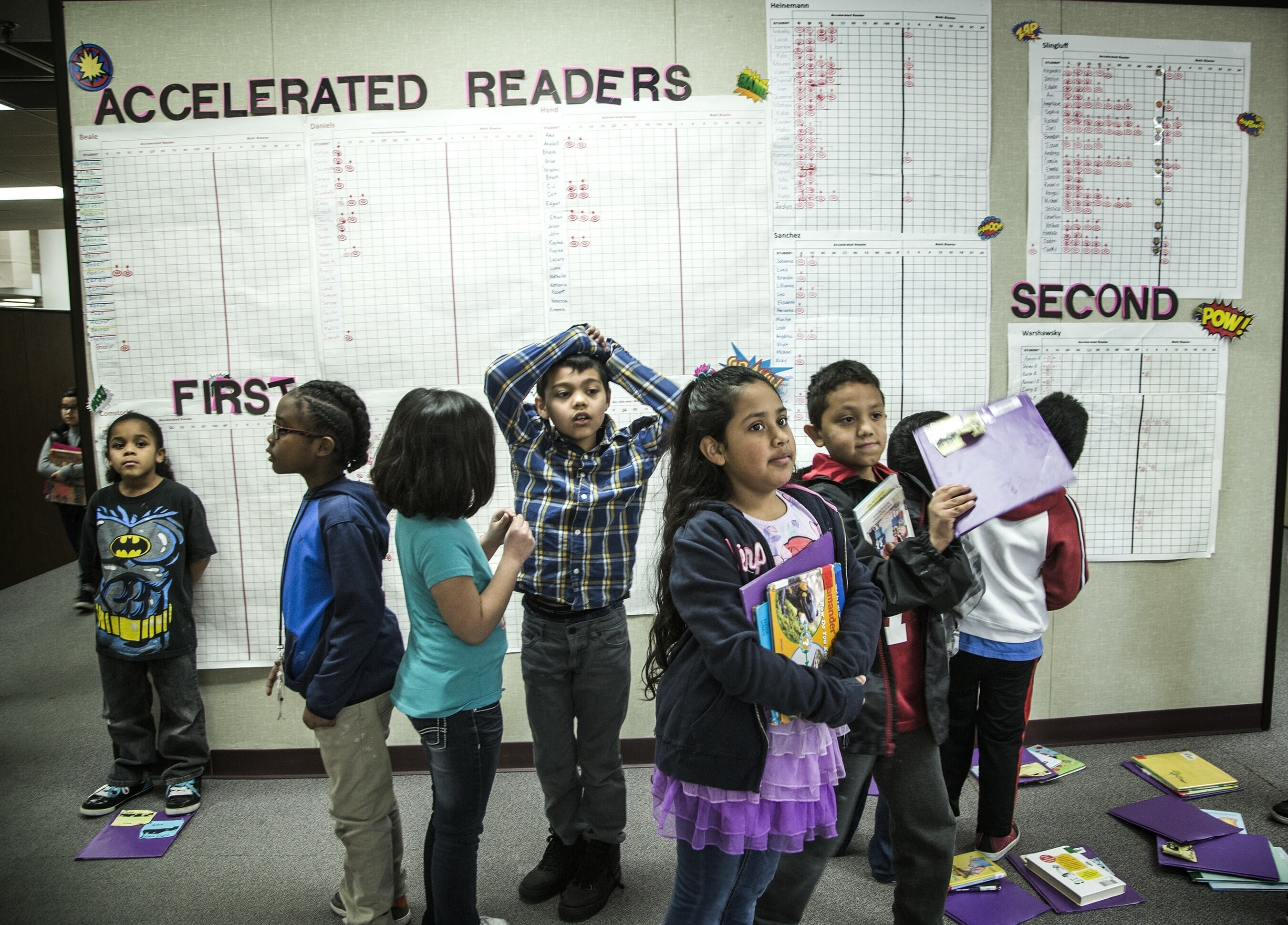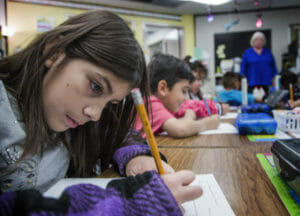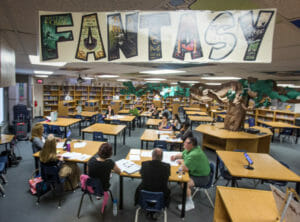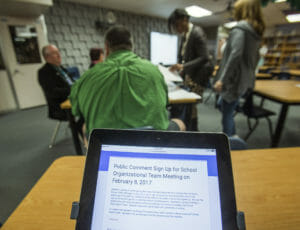New groups overseeing operations of schools have new voices: parents

As a sluggish computer struggled to load a screen, a momentary silence fell over a small group assembled inside Diskin Elementary School’s library on a recent afternoon.
The computer’s glacial speed frustrated Principal Elizabeth Smith as she attempted to give a presentation outlining the Spring Valley school’s goals. But the timing of the technological snafu couldn’t have been better given the budget conversation about to ensue.
“I didn’t realize this was as slow as it is,” Smith told the four parents and three staff members sitting near her at a square table, surrounded by waist-high bookshelves.
They’re members of the so-called “school organizational team,” or SOT, a newly minted group formed at every district school that’s charged with helping determine the building’s performance plan and strategic budget. The groups are a key component of the district’s ambitious, state-mandated reorganization effort, which hands more budgeting and decision-making power to each school.
The teams just started meeting over the past few weeks, but time is of the essence: Schools must submit their budgets for the 2017-2018 academic year by Feb. 22.

A new desktop computer for the library happened to be on the school’s wish list. Now, it was up to the SOT to decide how Diskin should allocate its roughly $3.5 million from the district and another $204,750 worth of federal Title 1 funds — additional money given to schools with large numbers of students from low-income families.
Tucked into an aging neighborhood, Diskin caters to a diverse student population, where the children, combined, speak 37 languages. Roughly 40 percent of students are considered “English language learners,” meaning they receive additional services, and 81 percent qualify for free or reduced price lunches. The school also hosts occasional English classes for adults, banking on the hope that parents’ increased language proficiency will benefit their children.
Embracing the cultural diversity is one of the school’s top goals, along with increasing students’ reading abilities and closing achievement gaps between racial and ethnic groups.
“We want students to keep their (native) language,” said Jim Lenahan, the school’s literacy specialist who sits on the SOT. “We want them to be bilingual.”
Nibbling on brownies and sipping water, the team members considered the school’s makeup as they pondered budget-oriented questions that, in theory, could improve learning for their students or children. Questions like this:
Should the school add a fourth teacher to the fourth grade?
(Yes, they said, because the current third-grade class has a wide range of skill levels. “We figure if we reduce that class size a bit, it would help catch them up,” Smith said.)
Should the school use its funding for a “humanities teacher” to create a math-oriented special focused on making arithmetic fun while boosting students’ math comprehension?
(This received overwhelming approval. “That would be really awesome,” said April McClure, a parent member of the SOT.)
Should the school use some of its Title 1 funds to purchase a set of iPad Air 2 devices for students in intermediate grades?
(Not right now, they decided. Instead, the SOT recommended purchasing new Chromebooks for the library because students of all ages can use them.)

The team didn’t actually approach the budget from scratch. The principal and another staff member led the discussion and showed mock-up budgets — subject to change pending the SOT’s input.
Why? It’s a steep learning curve. The parent members, who were elected to serve on the SOT, don’t necessarily know how schools operate. The head-scratching lingo of the education world alone can be difficult to comprehend.
Smith urged parents to speak up and ask questions if they’re confused. “We’re so used to talking in all those acronyms,” she said.
The ease-in approach relieved Mayrose Almendralo, an SOT member whose second-grade son attends Diskin. She’s eager to help make decisions but acknowledged the information seemed overwhelming at first.
Her other observation: “How little the budget is considering what they want teachers to do.”
Salaries for licensed staff members — like teachers, counselors and librarians — account for about 85 percent of the school’s $3.5 million budget from the district. Other expenses such as school supplies or renting a school bus for a field trip, which costs $100, quickly chew through the remaining, non-salary dollars.
“We don’t have lots of extra cash to deal with,” Smith said.
The financial reality isn’t anything new for school leaders. Diskin administrators have been doing strategic budgeting for a handful of years, Smith said. The parent participation this year through the SOT mirrors an advisory council and site-based decision-making model implemented in Florida counties, where Smith previously worked.

Smith’s an advocate of the arrangement because she said parent involvement leads to more buy in and, ultimately, better decisions.
“I’ve been waiting for this to come this far west,” she said. “I just think it’s a really good process.”
As for that new library computer? It made the cut. The SOT agreed to include the $674 expense in the school’s Title 1 budget.
***
The process doesn’t just involve decisions between Chromebooks or iPads. Twelve miles north of the elementary school, SOT members at Bridger Middle School were grappling with a reduction in their Title 1 funds, which school officials said fluctuate each year based on student demographics and the dollars available per pupil.
The North Las Vegas charter school, where nearly 85 percent of its students qualify for free or reduced price lunches, had been allocated $465,500 worth of Title 1 funds for this academic year. The budgeted amount for the 2017-2018 school year: $437,850.
The roughly 6 percent cut triggered a discussion about the teacher family aide position, currently covered by Title 1 dollars. Assistant Principal Ranada Johnson suggested moving the $45,503 position to the school’s strategic budget, which would result in decreases to other supply and service line items.
The obvious follow-up question from parent SOT members: What is a teacher family aide?
“That’s really supposed to be the liaison between parents and staff,” Johnson said.

The school’s teacher family aide, who speaks Spanish and has held the position for about 12 years, makes home visits when students miss multiple days of school or when parents don’t attend conferences, Johnson said. She also helps with translations and supports the deans.
Three-fourths of the school’s students are Hispanic, underscoring the need for a teacher family aide who can mitigate any language barriers those families and students face, Johnson said.
The SOT members ultimately agreed to explore whether the cost of the position could be split between two funding sources — Title 1 dollars and the money allocated to the school from the district.
Daniel Holstein, a parent SOT member, drives his sixth-grade son and seventh-grade daughter to Bridger from Summerlin each weekday because of the school’s strong science, mathematics and technology magnet program, he said. After hearing school staff explain the teacher family aide position, he supported finding a way to keep it.
“Any time you can add to getting the students the assistance they need, I think that’s great,” Holstein said the day after the meeting. “But obviously it’s going to go well above and beyond that.”
The budgeting decisions come at a time of transition for Bridger, which is in the midst of finding a new principal. The school’s previous leader was promoted within the district earlier this academic year.
The uncertainty regarding school leadership prompted the school’s librarian, Kirsten Lowry, to urge her fellow SOT members to recommend a distinct library budget as opposed to leaving that up to the discretion of the new principal. Lowry said she has been lucky that past Bridger principals have been fierce allies of the library, but that’s not always the case at other schools — a situation that can result in meager funding.
“I want the kids to have more,” Lowry told the SOT members seated in the school’s library, where a sprawling tree crafted from paper provided a cozy feel. “I want kids to come in here and have the books and resources they want.”

As quasi-guardians of public money, parent members also questioned Bridger staff about $16,000-some allotted for travel.
Lowry said that money covers all expenses, including airfare and hotels, for staff members who attend out-of-town conferences. The knowledge gained at conferences winds up benefiting the entire staff because the attendees share that information — whether it’s a new teaching method or tricks for weaving technology into the curriculum, she said.
“We go as cost effective as we can,” Lowry said. The school asks staff members to share hotel rooms and research the cheapest flights and lodging.
The explanation seemed to satisfy other SOT members, who didn’t ask further questions about it. Bridger’s SOT plans to meet again Feb. 16 to make final decisions about budget recommendations.
***
Open communication. Respect. Humor. Patience. Kindness. Open minds. Creativity. Transparency.
These are some of the values the Palo Verde High School SOT discussed at an early meeting and agreed to practice at all gatherings. So, as a reminder, the words and phrases appeared on a large screen at the beginning of a meeting last week, under a sentence that seemed to sum up the intent:
“We are a unified, collaborative team.”
The team dug into the details of the Summerlin high school’s budget at a previous meeting, so its main task this day was to give it one final look and take action. Consider an SOT action as more of a recommendation. While team members vote on specific issues, it isn’t a binding decision. Principals make the final determination because, at the end of the day, they’re the ones held responsible by the district for the school’s academic successes or shortcomings.
Principal Darren Sweikert came to the meeting with an update and request. He wanted the group’s permission to make a tweak to the budget based on projected student attendance next year.

It’s a problem that vexes schools across the district as they try to anticipate staffing and resource needs without knowing exactly how many students will occupy chairs the coming fall. The school district originally estimated that 3,166 students would attend Palo Verde next year, but updated numbers show the student population could be closer to 3,317, Sweikert said.
“You can do the math,” he told the SOT. “We are anticipating more than we’re allocated.”
The district doesn’t finalize each school’s enrollment until the official “Count Day” in September. Attendance that day determines the amount of money the school district receives from the state on a per-pupil basis and, thus, how much money each school receives. If schools have more students than projected, their budgets increase to reflect the actual enrollment.
That’s why Sweikert suggested shifting a portion of the budget dollars to the “additional personnel” category. It would give him greater flexibility to either hire more teachers or pay existing staff members to teach more courses than what they’re required by contract.
He offered this promise to the SOT: “Every month we meet, I will keep you in the loop of where I am with wanting to hire teachers.”
The Palo Verde team agreed to the change and unanimously approved the school’s roughly $11.8 million strategic budget.
“All right, thank you. That was a historic moment,” Sweikert said, eliciting a few chuckles from team members. “Congratulations!”
Anna Slighting, an SOT member whose son attends Palo Verde, said she considers this year’s budgeting process a trial run of sorts, given that it doesn’t include a weighted funding formula and uses average teacher salaries. The school district and other education advocacy groups are lobbying the Nevada Legislature to allocate money for a weighted funding formula, which would give more per-pupil dollars to students with extra needs. If the district applies a weighted funding formula and uses actual teacher salaries, that could change the dynamic of school budgets.
“As a parent, I feel like principals are doing the best they can with what they are given,” said Slighting, who’s a member of H.O.P.E. for Nevada, a parent group that advocates for education policy reform. “The real work is going to happen next year.”

Until then, the SOT members are learning the ins and outs of school operations and budgets and getting the hang of how to run the public meetings. At Palo Verde, that meant double-checking to make sure they allowed enough opportunities for public comment and brainstorming ways to increase parent attendance.
“We’ll get better at this,” one member quipped.
After all, it was only the group’s third time meeting.
_____________________________________________________________________
ALL ABOUT SCHOOL ORGANIZATIONAL TEAMS
Who’s on each team?
Each school organizational team consists of voting and nonvoting members. The voting members include two to four licensed staff members, one or two educational support professionals and three to six parents (representing 50 percent of the total voting members). The nonvoting members include the school principal, a student representative at secondary schools and one or more optional community members.
How are those people chosen?
Parent organizations at schools establish the process for electing parent or guardian members, but the principal runs the process if no such organization exists. Schools must notify parents and guardians about the opportunity to serve on the SOT, how to be placed on the ballot and when the vote will occur.
Licensed staff and education support professionals conduct votes to determine whom their representatives will be on the SOT. Students can ask to be placed on the ballot or be nominated by teachers or administrators. The student body then votes to elect a student representative.
After an SOT forms, the members decide if they want to add one or more community members to it.
SOT members serve until Oct. 1 of the year following their selection, and they may run for additional terms.
What does an SOT do?
The school organizational team gives advice and assistance to the principal regarding the school plan of operation, which includes academic initiatives and the budget. After the school plan of operation has been finalized, the team members help the principal implement it. The team also helps select a new principal if there’s a vacancy.
Although team members vote on recommendations, they’re essentially acting in an advisory capacity. The principal makes final decisions because he or she ultimately will be held accountable.
Can anyone attend SOT meetings?
Yes, the meetings are open to the public. Schools post meeting dates and agendas on their websites. The meetings also include time for public comment.
Caption: Students stands beside a sign shows student reading skills at Pat Diskin Elementary School in Las Vegas on Tuesday, Feb. 07, 2017. Photo by Jeff Scheid.
